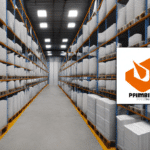Exploring the Pros and Cons of Amazon Seller Fulfilled Prime (SFP)
If you're an Amazon seller, you know that Prime shipping is a head-turner for buyers. But what if you could offer the same speedy delivery without using Amazon's own fulfillment centers? Enter Amazon Seller Fulfilled Prime, or SFP. In this article, we'll explore the pros and cons of using SFP, and help you decide if it's the right move for your business.
Understanding the Basics of Amazon Seller Fulfilled Prime
First things first – what exactly is Amazon Seller Fulfilled Prime? Essentially, it's a program that allows sellers to offer Prime two-day shipping without having to send their inventory to Amazon's warehouses. Instead, sellers ship orders directly to customers from their own facilities. This means that the seller is responsible for all aspects of fulfillment, including inventory management, picking, packing, and shipping.
One of the benefits of using Amazon Seller Fulfilled Prime is that it allows sellers to maintain control over their inventory. By keeping their inventory in their own facilities, sellers can ensure that they always have the products in stock and can quickly fulfill orders. Additionally, sellers can customize their packaging and branding, which can help them stand out from other sellers on Amazon.
However, it's important to note that Amazon has strict requirements for sellers who want to participate in the program. Sellers must meet certain performance metrics, such as maintaining a high on-time delivery rate and a low cancellation rate. They must also have a track record of providing excellent customer service. If a seller fails to meet these requirements, they may be removed from the program.
How Does Amazon Seller Fulfilled Prime Work?
Once you've enrolled in SFP and met the program's strict performance metrics, you can start offering Prime shipping on your products. Customers who have a Prime membership will see your listings marked as Prime-eligible and can choose your product over a non-Prime option. When a customer places an order, you'll receive a notification and have to fulfill the order within the required timeframe. Failure to meet Amazon's stringent delivery requirements can result in removal from the program.
One of the benefits of using Amazon Seller Fulfilled Prime is that you have more control over the shipping process. You can choose your own carrier and shipping method, which can help you save money on shipping costs. Additionally, you can use your own packaging materials, which can help you maintain your brand identity. However, it's important to note that you'll still need to meet Amazon's delivery requirements, which can be challenging for some sellers.
Benefits of Using Amazon Seller Fulfilled Prime for Your Business
One major advantage of using SFP is that it allows sellers to retain control over their inventory and fulfillment. This can be particularly appealing for sellers who have unique products or who struggle to meet Amazon's fulfillment requirements. Additionally, SFP can help sellers save money on storage fees, as they are not required to send inventory to Amazon's warehouses.
Offering Prime delivery can also boost sales and increase customer loyalty. Prime-eligible items appear first in search results, which can translate to higher visibility and increased purchases. Additionally, customers who have a Prime membership are more likely to choose a Prime-eligible product over a non-Prime option, as they know they'll get their item quickly and with free shipping.
Another benefit of using SFP is that it allows sellers to customize their shipping options to better meet the needs of their customers. For example, sellers can offer expedited shipping or weekend delivery options, which can be particularly appealing to customers who need their items quickly. Additionally, SFP allows sellers to use their own branding and packaging, which can help to create a more personalized and memorable customer experience. By offering a unique and customizable shipping experience, sellers can differentiate themselves from competitors and build a loyal customer base.
Drawbacks of Amazon Seller Fulfilled Prime You Should Know About
Of course, there are also some potential downsides to using SFP. One of the most significant is the high performance standards required by Amazon. To remain in the program, sellers must meet strict delivery metrics, including a 99% on-time shipping rate and a 4% or lower cancellation rate. Failure to meet these metrics can result in removal from the program.
Sellers who choose to use SFP also need to have a well-organized inventory and fulfillment process. With Amazon handling the shipping and storage in FBA, this responsibility falls entirely on the seller in SFP. In addition, sellers may need to invest in additional shipping and packing materials, which can add to their overhead costs.
Another potential drawback of using SFP is the limited access to Amazon's customer service. While FBA sellers have access to Amazon's customer service team to handle any issues with orders, SFP sellers are responsible for handling all customer inquiries and complaints themselves. This can be time-consuming and may require additional resources to manage effectively.
What is the Cost of Joining Amazon Seller Fulfilled Prime?
There is no fee to join Amazon Seller Fulfilled Prime, but sellers will need to have their own shipping arrangements and must meet performance requirements to remain in the program. Additionally, sellers will be responsible for all costs associated with fulfillment, including packing materials and shipping fees.
However, joining Amazon Seller Fulfilled Prime can lead to increased sales and exposure for your products. By offering Prime shipping, your products will be eligible for free two-day shipping for Prime members, which can attract more customers and increase your sales. Additionally, being part of the program can improve your seller metrics and increase your chances of winning the Buy Box.
How to Get Started with Amazon Seller Fulfilled Prime
To get started with SFP, sellers must first enroll in the program through their Amazon seller portal. They'll need to have a Professional Seller account, a strong track record of fulfilling orders on time, and their own shipping arrangements in place. Once enrolled, sellers can start offering Prime shipping on their products and will need to meet Amazon's strict performance standards to remain in the program.
One of the benefits of using SFP is that sellers have more control over their shipping process. They can choose their own carriers and shipping methods, which can lead to cost savings and faster delivery times for customers. Additionally, SFP sellers have access to Amazon's discounted shipping rates, which can further reduce their shipping costs.
However, it's important for sellers to carefully manage their inventory and shipping processes to ensure they meet Amazon's performance standards. This includes maintaining high on-time delivery rates, low cancellation rates, and accurate tracking information. Sellers who fail to meet these standards may be removed from the SFP program and lose their ability to offer Prime shipping.
Tips for Maximizing the Benefits of Amazon Seller Fulfilled Prime
To make the most of Amazon SFP, here are some tips:
- Ensure that your inventory and fulfillment processes are well-organized
- Invest in quality packing materials to ensure that products are shipped securely
- Monitor your metrics closely and work to improve any areas where you're struggling
- Offer items that are frequently in demand to take advantage of the benefits of Prime eligibility
Another important tip for maximizing the benefits of Amazon SFP is to provide excellent customer service. This includes responding promptly to customer inquiries and concerns, providing accurate product descriptions, and ensuring that products are delivered on time. By providing exceptional customer service, you can build a loyal customer base and increase your chances of receiving positive reviews, which can help boost your sales and improve your search rankings on Amazon.
Is Amazon Seller Fulfilled Prime Right for Your Business?
Whether or not SFP is the right choice for your business depends on your specific needs and goals. If you have a well-organized inventory and fulfillment process and can meet Amazon's performance standards, SFP can be an excellent way to offer Prime shipping while retaining control over your inventory. However, if you struggle with fulfillment or don't have the resources to meet Amazon's standards, FBA may be a more reliable option.
Another factor to consider when deciding whether to use SFP is the type of products you sell. If you sell products that are frequently out of stock or have a high return rate, SFP may not be the best option for your business. This is because Amazon requires SFP sellers to maintain a high level of inventory accuracy and customer satisfaction, and failing to meet these standards can result in account suspension or termination.
On the other hand, if you sell unique or niche products that are not available through FBA, SFP can be a great way to offer Prime shipping to your customers. Additionally, SFP can be a cost-effective option for businesses that already have their own fulfillment infrastructure in place, as it allows them to leverage their existing resources while still offering the benefits of Prime shipping.
Comparison between Amazon FBA and SFP: Which One to Choose?
When deciding between FBA and SFP, consider your inventory and shipping needs. FBA is a better option for sellers who have a large volume of inventory to store or who struggle with fulfillment. Since Amazon handles these aspects of the process, sellers can focus on other aspects of their business. SFP is a good option for those who want to retain control over their inventory and fulfillment but still offer Prime shipping to customers.
Case Studies: Success Stories of Businesses Using SFP on Amazon
SFP has been successful for many Amazon sellers, such as Carved, a company that creates custom wooden phone cases. By using SFP, Carved was able to improve their shipping speed and offer a better customer experience. Additionally, they were able to save money on storage fees and take advantage of the benefits of Prime eligibility.
Common Mistakes to Avoid when Using SFP on Amazon
Some common mistakes to avoid when using SFP include:
- Not investing in quality packing materials, which can result in damaged or lost items
- Not monitoring metrics closely and failing to improve areas where you're struggling
- Not having a well-organized inventory system, which can lead to errors and missed orders
- Not having a backup plan in case of an unexpected influx of orders
Best Practices for Managing Inventory when Using SFP
Some best practices for managing inventory when using SFP include:
- Setting clear reorder points to ensure that you don't run out of popular items
- Using inventory management software to help track stock levels and forecast demand
- Regularly auditing stock levels to identify any inaccuracies or discrepancies
- Keeping an eye on trends and adjusting your inventory accordingly
Understanding the Role of Shipping and Delivery in SFP
Shipping and delivery are critical components of SFP, as sellers are responsible for all aspects of fulfillment. This means coordinating with shipping carriers to ensure that orders are packed and shipped on time, and that tracking information is uploaded to Amazon. Sellers must meet Amazon's strict delivery metrics, so communication and planning are key components of success using SFP.
Conclusion: Is it Worth Joining Amazon Seller Fulfilled Prime?
Amazon Seller Fulfilled Prime can be a valuable tool for sellers who want to offer Prime shipping while retaining control over their inventory and fulfillment processes. However, it requires strong attention to detail, well-organized inventory, and high levels of performance. Ultimately, whether or not SFP is worth joining depends on your specific business needs and goals.






















